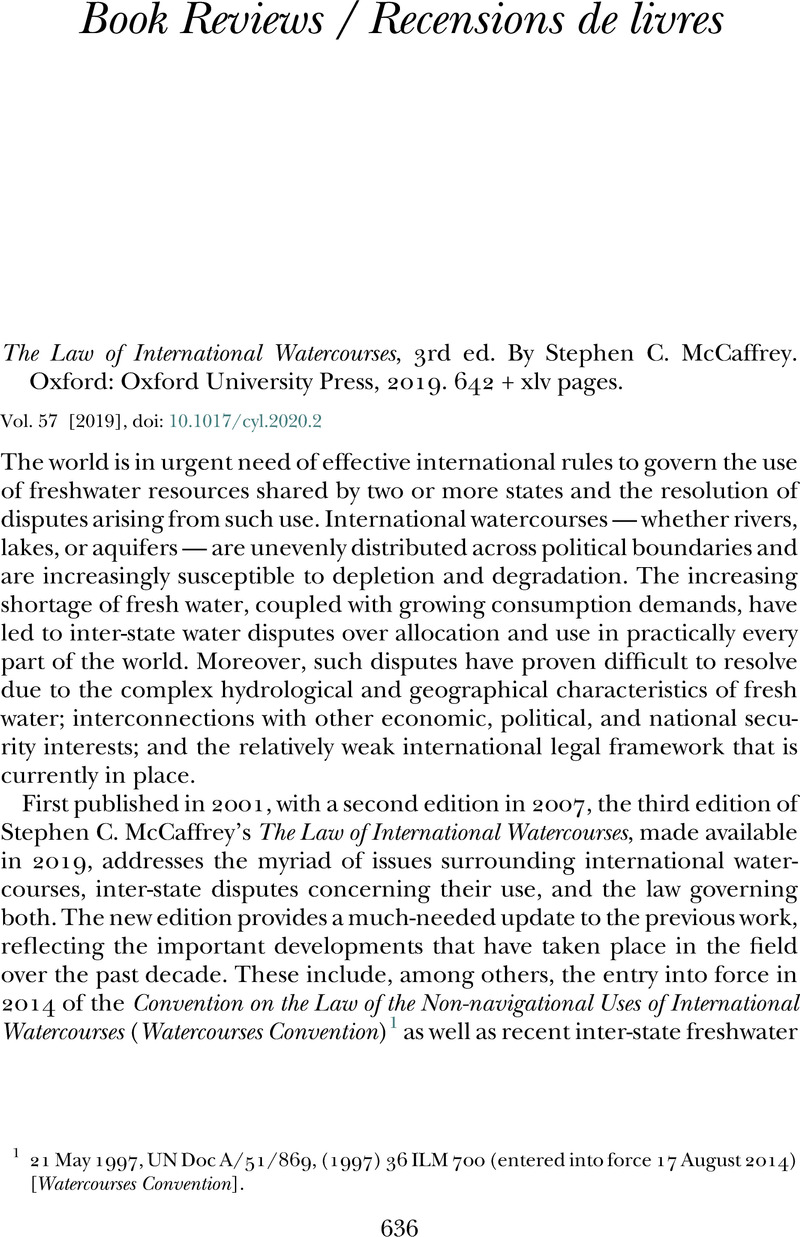No CrossRef data available.
Article contents
The Law of International Watercourses, 3rd ed. By Stephen C. McCaffrey. Oxford: Oxford University Press, 2019. 642 + xlv pages.
Published online by Cambridge University Press: 26 May 2020
Abstract

- Type
- Book Reviews/Recensions de livres
- Information
- Canadian Yearbook of International Law/Annuaire canadien de droit international , Volume 57 , November 2020 , pp. 636 - 641
- Copyright
- © The Canadian Yearbook of International Law/Annuaire canadien de droit international 2020
References
1 21 May 1997, UN Doc A/51/869, (1997) 36 ILM 700 (entered into force 17 August 2014) [Watercourses Convention].
2 Pulp Mills on the River Uruguay (Argentina v Uruguay), [2010] ICJ Rep 14; Certain Activities Carried Out by Nicaragua in the Border Area (Costa Rica v Nicaragua) and Construction of a Road in Costa Rica along the San Juan River (Nicaragua v Costa Rica), [2015] ICJ Rep 665 [Certain Activities Carried Out by Nicaragua]; Dispute over the Status and Use of the Waters of the Silala (Chile v Bolivia), “Application Instituting Proceedings Submitted by Chile” (6 June 2016), ICJ Pleadings (currently pending before the ICJ) [Chile v Bolivia Application].
3 Expert Determination on Points of Difference Referred by the Government of Pakistan under the Provisions of the Indus Waters Treaty, Executive Summary, Lausanne (12 February 2007), online: World Bank <http://siteresources.worldbank.org/SOUTHASIAEXT/Resources/223546-1171996340255/BagliharSummary.pdf>; Indus Waters Kishenganga Arbitration (Pakistan v India), Final Award (20 December 2013), online: Permanent Court of Arbitration <https://pcacases.com/web/sendAttach/48>.
4 McCaffrey, Stephen C, The Law of International Watercourses, 3rd ed (Oxford: Oxford University Press, 2019) at 99–116 Google Scholar.
5 Ibid at 162.
6 Ibid at 4.
7 Ibid at 7–12.
8 Ibid at 87–97.
9 17 March 1992, 1936 UNTS 269 (entered into force 6 October 1996).
10 McCaffrey, supra note 4 at 414–42.
11 Ibid at 432–34. See further Langford, Malcolm & Russell, Anna FS, eds, The Human Right to Water: Theory, Practice and Prospects (Cambridge: Cambridge University Press, 2017)CrossRefGoogle Scholar.
12 See e.g. Florida v Georgia, 138 S Ct 2502 (2018); Texas v New Mexico, 138 S Ct 954 (2018).
13 McCaffrey, supra note 4 at 291.
14 Agreement on the Nile River Basin Cooperative Framework, 14 May 2010, online: <www.nilebasin.org/images/docs/CFA%20-%20English%20%20FrenchVersion.pdf> (not in force). For more on the Grand Ethiopian Renaissance Dam dispute, see e.g. Salman MA Salman, “The Nile Basin Cooperative Framework Agreement: Disentangling the Gordian Knot” in Yihdego, Zeray et al, eds, The Grand Ethiopian Renaissance Dam and the Nile Basin: Implications for Transboundary Water Cooperation (Abingdon, UK: Routledge, 2019) 45 Google Scholar; Habatamu Alebachew, “International Legal Perspectives on the Utilization of Trans-boundary Rivers: The Case of the Ethiopian Renaissance (Nile) Dam” in Kidd, Michael et al, eds, Water and the Law: Towards Sustainability (Northampton, MA: Edward Elgar, 2014) 66 Google Scholar at 73–74, 80–81; Jenny R Kehl, “Water Security in Transboundary Systems: Cooperation in Intractable Conflicts and the Nile System” in Cahan, Jean A, ed, Water Security in the Middle East: Essays in Scientific and Social Cooperation (London: Anthem Press, 2017)Google Scholar 39 at 40.
15 For instance, in 2016, India requested that the World Bank appoint a Neutral Expert to resolve lingering disagreements, and Pakistan requested that it appoint a court of arbitration. World Bank, Press Release, “World Bank Declares Pause to Protect Indus Waters Treaty” (12 December 2016), online: <www.worldbank.org/en/news/press-release/2016/12/12/world-bank-declares-pause-protect-indus-water-treaty>.
16 Treaty between Canada and the United States Relating to Cooperative Development of the Water Resources of the Columbia River Basin, 17 January 1961, Can TS 1964 No 2 (entered into force 16 September 1964).
17 See Global Affairs Canada, News Release, “Canada and United States Launch Negotiations to Renew Columbia River Treaty” (22 May 2018), online: <www.canada.ca/en/global-affairs/news/2018/05/canada-and-united-states-launch-negotiations-to-renew-columbia-river-treaty.html>; see also United States, Department of State, Bureau of Western Hemisphere Affairs, “Columbia River Treaty Regime” (undated), online: <www.state.gov/columbia-river-treaty>.
18 See Certain Activities Carried Out by Nicaragua, supra note 2 at 785, Separate Opinion of Judge Donoghue (“I do not find it useful to draw distinctions between ‘procedural’ and ‘substantive’ obligations, as the Court has done”).
19 See e.g. Attila M Tanzi, “Substantializing the Procedural Obligations of International Water Law between Retributive and Distributive Justice” in Fabri, Hélène Ruiz et al, eds, A Bridge over Troubled Waters: Dispute Resolution in the Law of International Watercourses and the Law of the Sea (Leiden: Brill-Nijhoff, forthcoming)Google Scholar [on file with reviewer]; Owen McIntyre, “The World Court’s Ongoing Contribution to International Water Law: The Pulp Mills Case between Argentina and Uruguay” (2011) 4:2 Water Alternatives 124 at 143.
20 McCaffrey, supra note 4 at 526, does note that “the line separating obligations that are substantive from those that are procedural is not always a clear one … the ‘substantive’ obligation of equitable and reasonable utilization may itself be thought of as a process; and the ‘substantive’ obligation not to cause significant harm also serves to trigger a process.”
21 Reproduced in Report of the International Law Commission: Sixtieth Session (5 May–6 June and 7 July–8 August 2008), UN Doc A/63/10 (2008) at para 53.
22 McCaffrey, supra note 4 at 559–61.
23 Bolivia claims that it has sovereignty over the “artificial channels” and “artificial flow” of the Silala. Dispute over the Status and Use of the Waters of the Silala (Chile v Bolivia), Order of 15 November 2018, [2018] ICJ Rep 703 at 704. Chile, however, claims that the Silala crosses the border from Bolivia to Chile naturally as a result of gravity and that the artificial channels did not alter its natural flow. Chile v Bolivia Application, supra note 2 at paras 2, 21, 44.




